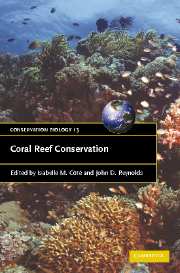Book contents
- Frontmatter
- Contents
- List of contributors
- Foreword
- Preface
- Part I Setting the stage
- Part II Uses and abuses: ecological and socio-economic issues
- 5 Challenges and accomplishments towards sustainable reef fisheries
- 6 Live food and non-food fisheries on coral reefs, and their potential management
- 7 Tourism and coral-reef-based conservation: can they coexist?
- 8 Longer-term impacts of climate change on coral reefs
- Part III The way forward: tools and approache
- Index
- Plate section
- References
6 - Live food and non-food fisheries on coral reefs, and their potential management
Published online by Cambridge University Press: 05 June 2012
- Frontmatter
- Contents
- List of contributors
- Foreword
- Preface
- Part I Setting the stage
- Part II Uses and abuses: ecological and socio-economic issues
- 5 Challenges and accomplishments towards sustainable reef fisheries
- 6 Live food and non-food fisheries on coral reefs, and their potential management
- 7 Tourism and coral-reef-based conservation: can they coexist?
- 8 Longer-term impacts of climate change on coral reefs
- Part III The way forward: tools and approache
- Index
- Plate section
- References
Summary
INTRODUCTION
Biology and exploitation of coral reef organisms remain very under-studied, particularly with respect to live food and non-food fisheries. Coral reefs are found in over 100 countries, supporting more than 4000 species of fish and 1000 species of reef-building corals (Paulay, 1997). The resources in these ecosystems are exploited by tens of millions of fishers and supply about 10% of the world's seafood (Moberg and Folke, 1999). Such fisheries can be expected to put a myriad of pressures on reef environments: (1) they remove the organisms directly, thus depleting populations; (2) they harm or disturb other individuals, thus disrupting populations; and (3) they place pressures on the larger reef ecosystem, through community change or habitat damage. Despite their ecological and economic importance, however, coral reef fisheries are largely overlooked in national management plans and in international record-keeping. Such data and analyses as do exist generally refer to fisheries intended for food.
This chapter synthesizes current knowledge about fisheries and trades in five forms of reef product that are primarily or entirely sought for reasons other than nutrition: ostentatious meals, aquarium display, curiosities, traditional medicines and bioprospecting for pharmaceuticals. This chapter thereby complements the previous chapter by McClanahan, which focuses on fisheries based on nutrition. I will here refer to ‘live food and non-food’ products to embrace these and other forms of exploitation not directed at supplying nutrition, while the term ‘food’ alone alludes to dead fish.
- Type
- Chapter
- Information
- Coral Reef Conservation , pp. 183 - 236Publisher: Cambridge University PressPrint publication year: 2006
References
- 8
- Cited by



